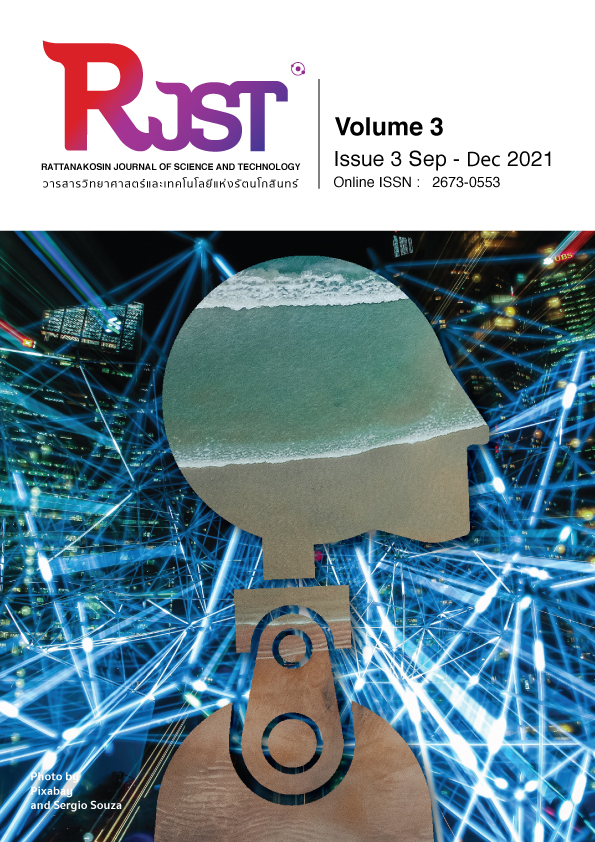Environmental impacts assessment of the life cycle asphalt rubber road
Main Article Content
Abstract
This research was studied the life cycle assessment of asphalt rubber mixed roads. The process is concentrated on mixed in the top layer of the surface thickness as 5 cm for the purpose of analyzing and evaluating the environmental impact. The pavement road surface analysis used product life cycle assessment techniques and suggestions on how to improve throughout the life cycle of the rubber road more effective and less impact on the environment as well as the process of construction of asphalt roads. In the life cycle assessment, the results showed the oxidation due to light-chemical reaction was about 50%. The effect of climate change and ecotoxicity on both land and water were 55%. of the potential for ozone depletion in the atmosphere and soil toxicity. The freshwater resources biological fossils were 82% for dehydration values in terms of maintenance, about 17% demonstrate environmental benefits and durability comparing the use of asphalt mixtures, latex with the common asphalt road.
Article Details

This work is licensed under a Creative Commons Attribution-NonCommercial-NoDerivatives 4.0 International License.
The content within the published articles, including images and tables, is copyrighted by Rajamangala University of Technology Rattanakosin. Any use of the article's content, text, ideas, images, or tables for commercial purposes in various formats requires permission from the journal's editorial board.
Rajamangala University of Technology Rattanakosin permits the use and dissemination of article files under the condition that proper attribution to the journal is provided and the content is not used for commercial purposes.
The opinions and views expressed in the articles are solely those of the respective authors and are not associated with Rajamangala University of Technology Rattanakosin or other faculty members in the university. The authors bear full responsibility for the content of their articles, including any errors, and are responsible for the content and editorial review. The editorial board is not responsible for the content or views expressed in the articles.
References
วันดี ลือสายวงศ์. (2551). วิธีประเมิน วัฏจักรชีวิต (Life Cycle Assessment; LCA) กลุ่ม ทดสอบโลหะและธาตุปริมาณน้อย โครงการเคมี กรมวิทยาศาสตร์บริการ, ออนไลน์. แหล่งที่มา : http://www.dss.go.th/ dssweb/starticles/files/cp_7_2550_LCA.pdf (17 เมษายน 2564).
เดช เฉิดสุวรรณรักษ์. (2551). การศึกษาระบบการจัดการ สิ่งแวดล้อม (The Environmental Management System – EMS), โครงการทัศนศึกษาเยาวชนไทย ร่วมใจอนุรักษ์สิ่งแวดล้อม (คน ป่า น้ำ) ครั้งที่ 3, ออนไลน์. แหล่งที่มา : http:// tccnaturewordpress.com/ (6 พฤษภาคม 2564).
นิรนาม. มปป. การศึกษาการประเมิน วัฏจักรชีวิตของกล่องกระดาษ, ออนไลน์. แหล่งที่มา: http://www.howproductsimpact.net/box/ (14 มิถุนายน 2564).
E. Eriksson, M. Blingeb, and G. Liivgren. (1996). “Life Cycle Assessment of the Road Transport Sector,” The Science of the Total Environment pp. 189/190, pp. 69-76,.
Patcharin Worathanakul. (2018). “Nanoparticles and Life Cycle Assessment,” Thailand Engineering Journal, vol. 61, no. 3, pp. 36-39, 2008. (Cover Story- Article in Thai).
Danning Li. et, al., (2021). Effects of rubber absorption on the aging resistance of hot and warm asphalt rubber binders prepared with waste tire rubber, Journal of Cleaner Production, Volume 303, 2021, 127082, ISSN 0959-6526, https://doi.org/10.1016/j.jclepro.2021.127082.
อนุเขตร์ กันทะวงศ์. (2547). “การศึกษาปัจจัยที่มีอิทธิพล ต่อการเลือกรูปแบบการขนส่งสินค้าระหว่าง จังหวัดสำหรับการขนส่งทางถนนและทางรถไฟ,” ภาควิชาวิศวกรรมโยธา คณะวิศวกรรมศาสตร์ มหาวิทยาลัยเชียงใหม่.
ศูนย์เฉพาะทางด้านการประเมินวัฏจักรชีวิตและพัฒนาผลิตภัณฑ์เชิงนิเวศเศรษฐกิจ. (2549). โครงการจัดทำฐานข้อมูลวัฏจักรชีวิตของวัสดุพื้นฐานและพลังงานของประเทศ. ศูนย์เทคโนโลยีโลหะและวัสดุแห่งชาติ (MTEC) สำนักงานพัฒนาวิทยาศาสตร์และเทคโนโลยีแห่งชาติ กระทรวงวิทยาศาสตร์และเทคโนโลยี.
อุษา สัตย์ซื่อ. (2552). ภาวะโลกร้อน (Global Warming), ออนไลน์. แหล่งที่มา: http://www.thaigoodview.com/library/teacheshow[lopburi/usa_s/global_warming/sec01p05.html: (9 มีนาคม 2564)
Thai Environment Institute Foundation. (2005). “Life Cycle Inventory for Cement Product and Steel Making Towards Sustainable Development,” Report of Life cycle assessment and product.
Prasert Pavasant. (2018). Document of modern environmental impact assessment based on the assessment of product’s life cycle, Center of Excellence on Hazardous Substance Management, Chulalongkorn University.
Worasit Hinthong. (2010). “The assessment of impacts to environment of Ball Valves production based on the assessment of life cycle,” Independent Studies of Master Degree Faculty of Engineering Management, Srinakharinwirot University.
Ta. (2000). “Life cycle assessment of product,” The Journal Rajamangala University of Technology Krungthep, vol.2, pp.27-34.
International Standard Organization. (1997). iso 14040 Environmental Management – Life Cycle Assessment Principles and Framework.
Jutharat Seusat. (2009). “Environmental impact assessment of a microwave oven based on eco-design,” Thesis of Master Degree, faculty of engineering, Thammasat University.
Pornpot Piamsomboon. N.d. Document of product life cycle assessment, faculty of science, Chulalongkorn University.
M.A. Curran and W Klopffer. (2007). “Life Cycle Assessment,” The International Journal of Life Cycle Assessment, no 11367, pp. 40-45.
Homs E.Graede, (1998). Streamlined Life-Cycle Assessment (pp.18-24). Prentice Hall: Bell Laboratories, Lucent Technology, School of Forestry and Environmental Studies, Yale University.
AASHTO T315 (2009), Standard Method of Test for Determining the Rheological Properties of Asphalt Binder Using a Dynamic Shear Rheometer (DSR), American Association of State Highway and Transportation Officials, Washington D.C.
Aravind.K, and Animesh Das (2006) Pavement design with central plant hot-mix recycled asphalt mixes, Construction and building materials, Vol 21, No.3, pp 28-936.

